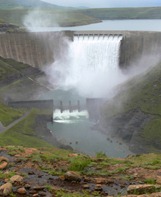Saving Energy by Saving Water: A Hidden Imperative
by Erica Gies, NEW YORK TIMES, May 17, 2010
 I n the run-up to the Copenhagen climate summit conference last year, water researchers and advocates held a special meeting to address the fact that water issues were absent from the draft negotiating text. This was a major oversight, given the amount of energy that is used to collect, treat, distribute and use water and wastewater.
I n the run-up to the Copenhagen climate summit conference last year, water researchers and advocates held a special meeting to address the fact that water issues were absent from the draft negotiating text. This was a major oversight, given the amount of energy that is used to collect, treat, distribute and use water and wastewater.
Just how much energy is consumed has not been measured in most places, but a 2005 energy policy report published by the state of California found that annual water-related energy consumption in the state accounted for 19 percent of electricity consumption, 32 percent natural gas consumption, and 88 million gallons, or 333 million liters, of diesel fuel. River Network, an organization that advocates water conservation, has extrapolated that data nationally. In a report last year it calculated that Americans use 520 megawatt-hours, or 13 percent of U.S. electricity consumption, on water.
This level of consumption offers an opportunity, said Bevan Griffiths-Sattenspiel, a project coordinator with the network. “Reducing your water use not only saves energy and greenhouse gas emissions, but it’s also a key way to adapt to climate change because most effects of global warming will be manifest through our water resources,” he said.
The relationship between power and water utilities is lopsided. While electric utilities pay little or nothing for their water, the largest operating cost for water utilities is often their electricity bill.
Santa Clara Valley Water District has drawn a lesson from that. Serving 1.8 million residents in the southern part of the San Francisco Bay Area, including Silicon Valley, it has had a water conservation program since the early 1990s. In 2007, it released a report analyzing its success in terms of energy conservation, emissions mitigation and cost. From 1993 to 2006, the report said, the district saved approximately 1.42 billion kilowatt-hours of energy, equivalent to the annual power used by 207,000 households, through financial incentives, advisory programs and infrastructure investments that cut water consumption.
That translated into a financial saving of about $183 million and an avoidance of 335,000 tons of carbon dioxide emissions.
California is not the only U.S. state with water supply issues. By 2013, at least 36 states expect shortages, according to a 2003 study by the U.S. Government Accountability Office. [Read rest of story]


